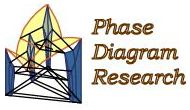|
Phase Diagrams & Computational Thermodynamics
Applications
|
|
APPLICATION OF PHASE DIAGRAMS IN SOLIDIFICATION AND CASTING PROBLEMS
The analysis of problems involving the casting of alloys requires a complex blend of fluid mechanics, heat flow, chemical diffusion and solid mechanics. However, the phase diagram, especially when applied to the character of a material at a given position and time (local equilibrium), provides the basic constitutive relation regarding the physical state of the alloy. The information from a phase diagram must be placed upon a framework of mass, momentum and energy balance equations that describe the kinetics of a given situation. Since 1950, great progress has been made in the analysis of solidification problems using this concept of local equilibrium. A major use of phase diagrams comes about in the prediction of the degree of microsegregation and inclusion (or second-phase) formation. Modern approaches to the microsegregation problem accept the inevitable difficulty of solid state chemical diffusion compared to the liquid state and replace mass balance accompanied by complete diffusion, i.e., the "lever rule" with mass balance accompanied by incomplete diffusion (the Scheil equation). This equation when coupled with the partition coefficients of the various solutes can be used to estimate the liquid composition (and solid composition) as a function of fraction solid or, equivalently, the fraction solid as a function of temperature. Partition coefficients can be read directly from the phase diagram. Additionally, the solidification path can be calculated and the prediction made of the fraction solid when the liquid can begin formation of second-phase particles, inclusions or eutectics. Such liquid compositions are directly read from phase diagrams. This analysis yields an estimate for the volume fraction of all the phases that will occur in the cast structure, as well as the magnitude of concentration gradients which will exist in the cast solid. In the prediction of macrosegregation, the mass balance is augmented by fluid flow terms to predict local increases or decreases in the fraction of second-phase particles and concomitant shifts in the average composition in that location. Such analysis has been successfully applied to describe chill zone, centerline, cross section change and "V" segregation. Data for this require parameters read directly from phase diagrams. The prediction of fraction solid as a function of temperature described above, when coupled with a heat flow analysis of castings, yields the thickness of the mushy zone or liquid-solid region in castings. The thickness of the mushy zone is very important for the prediction and control of microporosity and gas porosity, as well as hot tearing characteristics of castings. The former are generally caused by the difficulty of fluid flow through the mushy zone to feed solidification shrinkage, whereas the latter is caused by the formation of large thermal contraction stresses acting on an insufficiently strong solid in a mushy zone. Gas porosity analysis also requires data regarding the solubility of gases in metals. Mushy-zone thickness has also been associated with grain multiplication and the formation of equiaxed zone of ingot castings. Theories of dendrite coarsening, which lead to predictions of dendrite arm spacings in castings as a function of local solidification time, rely on the partition coefficient and liquidus slope from the phase diagram as parameters. Dendrite arm spacings are correlated to the strength of castings as well as to homogenization times required for subsequent heat treatment of castings. The analysis of cast structures produced by rapid solidification has presented a new challenge to the usefulness of phase diagrams. Here the phase diagram is best viewed as a representation of the thermodynamically possible states of alloys. It will, in general, not be able to describe the exact state of the system, but it will place bounds on the temperatures and compositions at which certain transformations can occur. In this situation, the phase diagram is most useful when the underlying free-energy functions for the phases are known or are estimated from the existing measured phase-diagram features. These functions can then be used to construct metastable extensions of phase boundaries and construct new phase diagram boundaries such as a To curve, which place a bound on partitionless crystallization. Both of these are useful in the analysis of enhanced solubility during rapid solidification. Such constructions must be done carefully and compared to experiments, for at best they are interpolations and at work extrapolations. They do provide, however, an extremely useful starting point for the analysis of rapid solidification problems. |
|
|
|
Materials Science and Engineering Division | metallurgy@nist.gov Home | Personnel | Research Opportunities The National Institute of Standards and Technology (NIST) is an agency of the U.S. Commerce Department. Privacy policy / security notice / accessibility statement / Disclaimer / Freedom of Information Act (FOIA) / No Fear Act Policy / ExpectMore.gov (performance of federal programs) / NIST Information Quality Standards |

